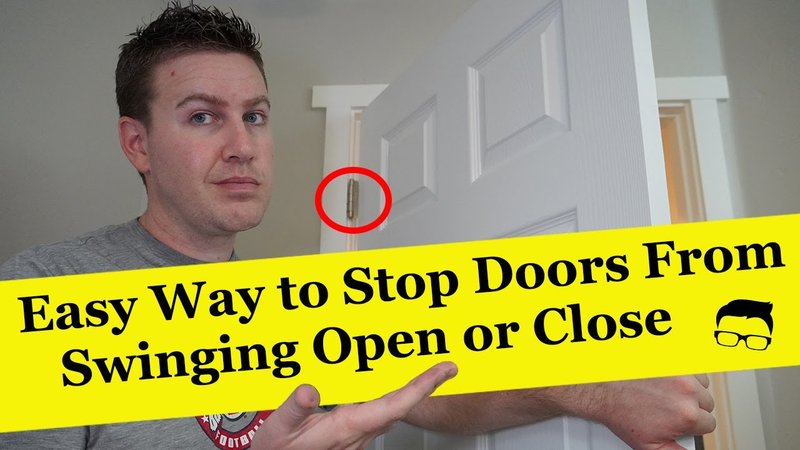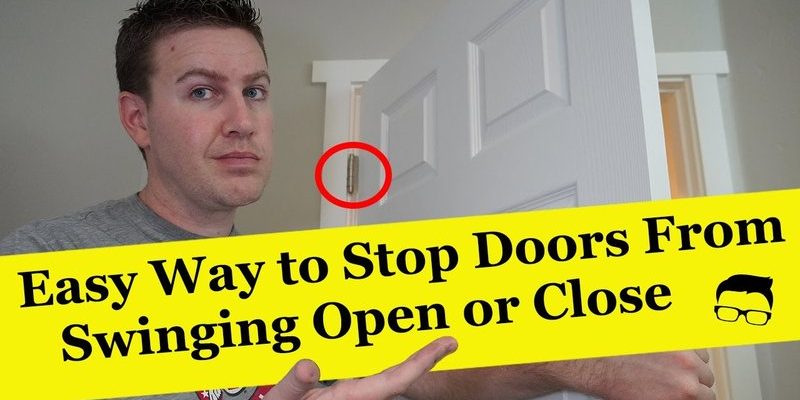
Here’s the thing: an exterior door that won’t stay put isn’t just a quirky house quirk. It can mess with your heating and cooling bills, cause security concerns, and even drive your pets (and you) a little nuts. If you’ve already checked the hinges, it’s time to roll up your sleeves and dig into some less obvious causes. We’ll look beyond the basics—no matter if your swinging door happens with a classic wooden entryway or a modern steel brand like Therma-Tru or JELD-WEN. Let’s walk through some real fixes for that stubborn, self-moving exterior door.
What Makes a Door Swing on Its Own (Besides Hinges)?
You might be wondering, “If it’s not the hinges, what’s left?” Doors are more like puzzles than most people realize. The way they act depends on a mix of balance, pressure, and even the structure of your house. Sometimes, something as simple as a sloped floor or wonky frame can send your door gliding like a haunted house prop.
Here’s the thing: doors want to find their balance. If the frame isn’t level, gravity will do its thing—pulling the door one way or the other. Then there’s air pressure. Ever notice your door swinging open whenever you turn on the bathroom fan or dryer? That’s a sign your house is setting up a draft, tugging on the door. Even brand-new, factory-built doors like those from Pella or Andersen can behave this way if the installation overlooked these details.
Don’t forget about the latch and strike plate, either. If the latch doesn’t catch just right, the smallest breeze or tilt can get your door moving. Picture it like a kid on a playground swing: give a nudge, and off it goes. Sometimes, the solution is right under your nose—but hidden beneath years of little adjustments and settling.
How to Check If Your Door Frame or Floor Is Off
Before you start blaming ghosts or gremlins, check if your floor or frame is uneven. Even a slight tilt in the threshold or door jamb can send your exterior door swinging like it’s auditioning for a scary movie. Here’s a simple way to spot trouble: grab a basic bubble level and start from the threshold upward.
Run the level along the bottom of the door frame and up each side. If the bubble veers off center, you’ve got a slope. Sometimes, you’ll even see gaps between wood and floor, especially in older homes or after foundation settling. Even brand-new exterior doors from big brands can end up crooked if the installer was in a rush, or if your house has shifted over time.
If you don’t have a level, try this: open the door halfway and let go. If it swings open or shut fast, gravity is at work. On the other hand, a perfectly balanced door should pretty much stay put. Floors that aren’t level can be fixed with shims or by professionally adjusting the sill. Door frames can sometimes be adjusted by loosening and re-fastening screws, but don’t force anything—wood and metal frames can crack or warp if handled roughly.
Common Air Pressure Problems That Move Doors
Let me explain why your laundry day could be causing your exterior door to swing shut. Homes aren’t airtight—there’s always airflow coming in and out. When big appliances like bathroom fans, dryers, or kitchen range hoods are running, they push air out, creating slight pressure differences inside your house.
This negative pressure can actually pull doors closed (or pop them open). If a door is loosely latched or the weatherstripping isn’t sealing well, even a small pressure change will set it moving. Honestly, this is one of those house quirks that drives people nuts—and it’s easy to overlook because the cause isn’t visible.
Here’s a quick troubleshooting step: try opening your door the next time your dryer or a big fan is on. Notice if it suddenly swings by itself or feels pulled one way. Tightening your latch or adding better weatherstripping can help, but if the pressure problem is big, you might need to look at venting or even adjusting your HVAC systems. It sounds complicated, but often, adding a vent or slightly cracking a window can balance out the pressure, making your door behave again.
Latches, Locks, and Strike Plates: The Hidden Movers
If you’ve ever noticed your exterior door click shut but still move on its own, chances are the latch or lock isn’t catching like it should. Over time, the strike plate (the metal part on the door frame where the latch fits) can drift out of alignment. Even a millimeter off can let the door slip instead of holding firm.
To test this, slowly close your door and watch how the latch lines up with the strike plate. If you have to really shove or jiggle the handle for it to snap in, it’s probably misaligned. Sometimes, loose screws or shifting wood cause the strike plate to sag or tilt. If you’ve just had new doors or locks installed—especially with brands like Kwikset or Schlage—make sure everything’s tight. A loose strike plate is like an off-track zipper: it works until it doesn’t.
Fixing this can be simple. Tighten screws, raise or lower the plate, or add a little graphite lubricant to the latch. If the hole for the latch (the mortise) is too small or rough, a small file can smooth things out. This is the kind of troubleshooting that doesn’t take much time but can totally change how your exterior door operates—no need to replace expensive parts or hire a pro unless the door frame is badly warped.
When Weatherstripping Gets in the Way
Weatherstripping is the soft material around your exterior door that seals out drafts and rain. But here’s something a lot of people miss: if it’s too thick, too old, or not installed right, it can actually push your door open or keep it from latching. Weatherstripping might sound boring, but it plays a bigger role in troubleshooting than most people realize.
Start by looking at the strips around your door. Are they torn, jammed, or sticking out? If so, your door might bounce off the frame instead of closing snugly. That bounce can be just enough to let the door drift open on its own. Cheaper weatherstripping can even compress unevenly, causing gaps in some spots and bulges in others.
Here’s a tip: replace worn weatherstripping with the right thickness for your door brand. Don’t force thick foam into a tight space. If you have a newer brand like Therma-Tru, check the manufacturer’s guide for recommended parts before buying replacements. A snug, even seal should let the latch click fully into place, without fighting back. Small fix, big difference.
Troubleshooting a Swollen or Warped Door
Wooden exterior doors are tough but not invincible. Heat, humidity, and rain can warp or swell them just enough to throw off their balance. Even metal and fiberglass doors from top brands might flex in extreme weather. If you notice rubbing, sticking, or visible gaps, swelling is likely at play.
Test this by slowly opening and closing your door, watching for any spots where it sticks or drags. You can also check the edges—if one side looks swollen or feels soft, moisture may have seeped in. Warped doors often swing one way because the misshapen edge lifts or drops the rest of the door. It’s like a seesaw with a heavy kid on one side: the balance is off.
To fix minor warps, try tightening the screws at the top or bottom hinges (even if the hinges aren’t loose, sometimes a little adjustment helps). For bigger issues, you may need to sand down swollen spots or, in some cases, dry out the door and reseal it. Always make sure to paint or seal exposed wood to prevent future swelling. If metal doors warp, check for dents or bent edges, which can be tapped gently back into shape with a rubber mallet.
Simple Fixes That Don’t Involve Replacing the Door
You don’t need fancy tools or expert skills to stop an exterior door from swinging on its own. Sometimes, a few household items are all it takes. For a door that drifts just a bit, adding a small rubber bumper or wedge behind the door frame can do wonders—kind of like parking your car with the wheels turned to stop it from rolling away.
If you find your latch or strike plate is just a tad off, try moving the strike plate slightly or adding a thin washer behind its screws. These tiny tweaks can make your door latch more securely without drilling new holes or replacing parts. For pressure or draft problems, a draft stopper or a rolled-up towel at the base can help test if airflow is the issue before investing in bigger solutions.
If none of these work, it might be worth calling in a pro for a quick assessment. Sometimes, what looks like a small tilt is hiding a bigger structural issue—especially if your home is older or you’ve had recent foundation work done. But most of the time, a little patience and troubleshooting will do the trick.
When Should You Consider Replacing Your Exterior Door?
Let’s be honest—sometimes, you just can’t fix a door that won’t behave. If you’ve tried every troubleshooting step, and your exterior door still swings open or closed on its own, replacement might be your best bet. Here’s how to know when it’s time.
- Severe warping that can’t be sanded or straightened without damaging the door.
- Large gaps between the door and frame, even after adjusting the frame or hardware.
- Repeated water damage or rot, usually at the bottom edge.
- Persistent draft or pressure issues that simpler fixes can’t solve.
Newer exterior doors from brands like Pella, JELD-WEN, or Therma-Tru are designed to resist warping and weather better than older models. If your door is decades old (or came with the house and you don’t know the history), upgrading can improve energy efficiency, security, and peace of mind. Don’t forget—you can always save the old hardware if you’re replacing the door, and sometimes a universal latch or strike plate will work just fine across brands.
If you’re on the fence, compare the cost and hassle of repeated fixes with the long-term benefits and security of a new door. Sometimes, starting fresh is the simplest solution.
Wrapping Up: Getting Your Exterior Door to Behave
A self-swinging exterior door is more than just a minor nuisance—it’s a problem that can affect your entire home. But with a careful approach to troubleshooting, you can usually find and fix the real cause without calling in a professional right away. From uneven floors and pressure problems to latch alignment and weatherstripping, the best fixes are often the least expected.
Next time your door swings open or shut by itself, go step by step. Check the frame and floor, listen for drafts, and inspect the latch and weatherstripping before reaching for the replacement catalog. Honestly, a few quick adjustments or a tiny part swap is usually all it takes to make your exterior door behave again—saving you time, money, and a little sanity in the process.
